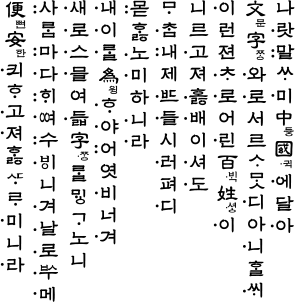Hunminjeongeum
| Hunminjeongeum | |
| File:Hunmingeongum.jpg | |
| Korean name | |
|---|---|
| Hangul | 훈민정음 (modern Korean) / 훈민져ᇰᅙᅳᆷ (original name) |
| Hanja | 訓民正音 |
| Revised Romanization | Hunminjeong(-)eum |
| McCune–Reischauer | Hunminjŏngŭm |
Promulgated in September or October 1446, Hunminjeongeum (lit. The Correct/Proper Sounds for the Instruction of the People) was an entirely new and native script for the Korean people. The script was initially named after the publication, but later came to be known as hangul. It was created so that the common people illiterate in hanja could accurately and easily read and write the Korean language. Its supposed publication date, October 9, is now Hangul Day in South Korea.
Content
The publication is written in Classical Chinese and contains a preface, the alphabet letters (jamo), and brief descriptions of their corresponding sounds. It is later supplemented by a longer document called Hunminjeongeum Haerye. To distinguish it from its supplement, Hunminjeongeum is sometimes called the "Samples and Significance Edition of Hunminjeongeum" (훈민정음예의본; 訓民正音例義本).
The Classical Chinese of the Hunminjeongeum has been partly translated into Middle Korean. This translation is found together with Worinseokbo, and is called the Hunminjeongeum Eonhaebon.
The first paragraph of the document reveals King Sejong's motivation for creating hangul. Excerpts from the Eonhaebon:
- In Old Hangul:[1]
- Translation:
- Because the speech of the country is different from that of China, it [the spoken language] doesn't match the [Chinese] letters. Therefore, even if the ignorant want to communicate, many of them cannot achieve their intent. Because I am saddened by this, I have newly made 28 letters. It is my intention that everybody learn the letters easily so that they can conveniently use them everyday.
Versions
The manuscript of the original Hunminjeongeum has two versions:
- Seven pages of hanja and written in Classical Chinese, except where the hangul letters are mentioned. Three copies are left:
- The Eonhaebon, 36 pages, extensively annotated in hangul, with all hanja transcribed with small hangul to their lower right, as can be seen in the image at the top of this article. The hangul were written in both ink-brush and geometric styles. Four copies are left:
See also
References
- ^ a b KTUG.or.kr. "Hunminjeongeum Eonhaebon". Retrieved 2006-07-14. Linked from KTUG's Hanyang PUA Table Project. Based on data from The 21st Century Sejong Project
External links
- Scanned copy of the Eonhae
- The Hunmin Chongum Manuscript - UNESCO Memory of the World International Register web page
- National Memory Heritage Service provides the pictures of the book.


